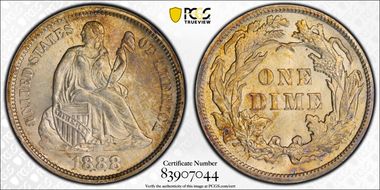Louis Maracellus Seeman (1888-1978), Lily Olive Knight (1888-1947), Margaret Safford Paterson (1888-?) 的钱币相册
The 1888 Three-Cent Nickel boasts the last of the "big" mintages from the 1880's, but at 36,501 pieces, the mintage is still tiny by any standard. This date compares favorably with the 1879, which has just a slightly higher mintage; both dates are priced nearly the same in all grades. Numerous Gem examples exist of this date, with dozens available in MS65, MS66, and MS67. In MS68, the population drops down to a mere one -- a lovely PCGS MS68 (which ranks as the finest known of this date). In general, this date comes well struck, and almost always shows all of the vertical lines in the Roman numeral III on the reverse. Picky collectors should select pieces with booming luster and as few carbon flecks as possible.
The 1888 Liberty Head Nickel has a mintage similar to that of the 1912-D, and both coins are valued similarly across the grade spectrum. Only eight other dates in the series have a lower mintage (nine, if you count the 1913 Liberty Nickel), making it one of the more popular, early dates. The most common Mint State grade for the 1888 Nickel is MS-64, followed by MS-63. Gems are scarce and superb exmples are essentially non-existent. The finest 1888 Nickel certified by PCGS (as of December 2011) is a single MS-66+. Collectors should seek spot-free examples that show a strong strike, especially on the obverse stars and the ear of corn on the lower left reverse.
Philadelphia Mint circulation strike quarters from 1879-1889 have low mintages ranging from 5,000 to 15,200. The reason for these tiny mintage figures was the Bland-Allison Silver Act of 1878. The Act mandated the minting of prodigious amounts of dollar coins to satisfy the demands of Western mining interests. This taxed the Mint's coining and die making machinery which resulted in meager production of sorely needed minor coinage. The situation was not corrected until 1892 with the introduction of the new Barber coinage. With survival estimates in the 15% range, circulation strike quarters of these dates were, and still are, highly sought by date collectors, and hoarded by some.
The 1888 Half Dollar has the largest mintage of any of the Half Dollars of the 1880's, but 12,001 coins is admittedly a very small quantity by any measure. Even the vaunted 1878-S Half Dollars has a mintage of 12,000 coins and it is worth tens of thousands of dollars even in the lowest grades. Because of the small mintage, most 1888 Half Dollars are either Prooflike and/or highly reflective, and they are often confused with Proofs. Hundreds of certified Mint State examples exist, with dozens available in each of the grades from MS62 to MS66. Superb 1888 Half Dollars are true condition-rarities.
Hoard coins: Like many of its sister New Orleans issues, the 1888-O dollars dribbled out of government storage and into the coin market in small quantities in 1946 and during the 1950s, especially from about 1955 to 1957-1958. Some of these came from the Treasury Building in Washington, D.C., where they had been stored since the New Orleans Mint ceased operations. In 1957, Harry J. Forman was one of several dealers who had this issue for sale in large quantities. Circulated grades: Circulated 1888-O Morgan dollars are very common in all grades up through and including AU-58. Mint State grades: This issue is very plentiful in Mint State, particularly in grades from MS-60 to MS-62, of which 100,000 to 200,000 are believed to exist, although this estimate may be on the low side-particularly if the Philadelphia vault hoard was larger than thought. MS-63 coins are plentiful. MS-64 coins are also common, perhaps to the extent of 20,000 to 35,000 coins. At the MS-65 level, the 1888-O is slightly scarce, with an estimated population of 4,000 o 8,000 pieces. The strike of 1888-O dollars varies from weak to sharp but is usually average to weak, with average to dull lustre. Cherrypicking is advised to acquire sharp specimen
Production low: For reasons that are not clear, production of silver dollars remained low at the San Francisco Mint during this era. The greatest mintages occurred in Philadelphia and New Orleans. Hoard coins: The market and hoard history of the 1888-S bears a close resemblance to its cousin, the 1887-S. On the numismatic market the 1888-S was considered to be quite scarce in Mint State, until bags were released in 1942 from storage in the San Francisco Mint. From then until the mid-1950s, quantities could be obtained for face value from that source. In 1956, bags were released in Montana. However, dealer and collector interest was limited, and investor interest was nil. Most that were paid out went to Nevada casinos or to banks, where they were put into circulation and quickly descended the grading ladder in AU or lower levels. Mint State grades: Mint State 1888-S dollars are scarce in comparison to certain earlier San Francisco Mint dollars of the decade, but on an absolute basis they are often encountered. Most specimens are in lower Mint State levels from MS-60 through 62, at which plateau an estimated 30,000 to 50,000 remain, above which are 10,000 to 18,000 MS-63 coins. MS-64 1888-S dollars are scarce, with an estimated population of 3,000 to 5,000. In the context of the series, it is not stretching things to call an MS- 65 rare, with perhaps 400 to 700 believed to survive. The striking quality of 1888-S dollars is often unsatisfactory. Specimens are usually weakly struck at the centers. However, sharply struck coins also exist in large numbers. The lustre varies from satiny to frosty but is often the latter.






























